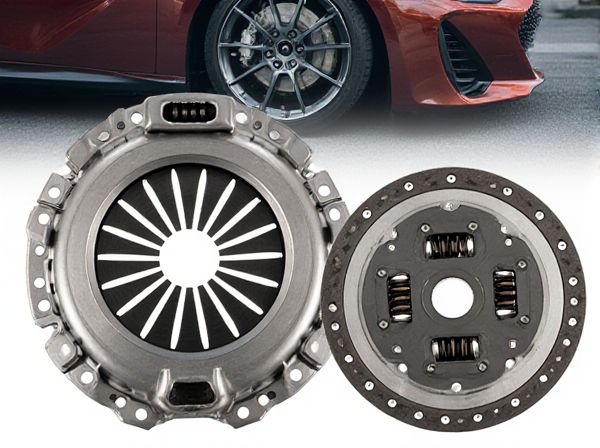
Photo illustration: Twin Friction Clutch vs Single Friction Clutch
Twin friction clutches provide enhanced torque capacity and improved heat dissipation compared to single friction clutches, making them ideal for heavy-duty applications. Single friction clutches are simpler in design, cost-effective, and suitable for lighter loads with less frequent use. Choosing between the two depends on your vehicle's performance requirements and operating conditions.
Table of Comparison
| Feature | Twin Friction Clutch | Single Friction Clutch |
|---|---|---|
| Design | Two friction discs for increased surface area | One friction disc |
| Torque Capacity | Higher torque handling capability | Standard torque capacity |
| Heat Dissipation | Better heat dissipation due to dual friction faces | Lower heat dissipation efficiency |
| Durability | Longer service life under heavy use | Shorter lifespan in demanding conditions |
| Cost | More expensive due to complex design | Less expensive and simpler |
| Usage | Ideal for high-performance and heavy-duty vehicles | Common in standard passenger cars |
Introduction to Friction Clutch Types
Twin friction clutches feature two friction discs that increase torque transmission capacity and improve heat dissipation compared to single friction clutches, which use one friction disc. Single friction clutches provide simpler design and lighter weight, making them suitable for applications with lower torque demands and cost sensitivity. Understanding the distinct structural and performance characteristics of twin and single friction clutches is essential for selecting the optimal clutch type in automotive and industrial machinery.
Twin Friction Clutch: Overview and Key Features
Twin friction clutches offer enhanced torque transmission by utilizing two friction surfaces, which significantly improve clutch performance and durability compared to single friction clutches. These clutches provide smoother engagement, greater load capacity, and reduced wear, making them ideal for high-performance automotive and industrial applications. Their design allows for better heat dissipation and increased efficiency, resulting in longer service life and reliable operation under demanding conditions.
Single Friction Clutch: Overview and Key Features
Single friction clutches utilize a single friction disc to engage and disengage the power transmission between the engine and drivetrain, offering simplicity and cost-effectiveness in various automotive and industrial applications. Key features include lower manufacturing and maintenance costs, straightforward design, ease of replacement, and reliable performance under moderate torque loads. While single friction clutches are suitable for standard vehicles, they may experience increased wear and reduced heat dissipation compared to twin friction clutches, which utilize two friction surfaces for enhanced durability and torque capacity.
Structural Differences Between Twin and Single Friction Clutches
Twin friction clutches feature two friction plates separated by a steel plate, effectively doubling the friction surface area compared to single friction clutches, which contain only one friction plate. This structural design enhances torque transmission capacity and heat dissipation in twin friction clutches, making them more suitable for high-performance and heavy-duty applications. In contrast, single friction clutches have a simpler, lighter construction that offers easier maintenance but lower torque capacity and heat tolerance.
Performance Comparison: Twin vs Single Clutch
Twin friction clutches exhibit superior heat dissipation and load distribution compared to single friction clutches, resulting in enhanced durability and consistent performance under high-stress conditions. The twin configuration reduces slippage and offers smoother engagement, improving vehicle acceleration and responsiveness. In contrast, single friction clutches tend to wear out faster due to concentrated friction and are more prone to overheating during prolonged or aggressive use.
Durability and Maintenance Considerations
Twin friction clutches offer enhanced durability due to their ability to distribute frictional forces across two friction surfaces, reducing wear and extending component lifespan compared to single friction clutches. Maintenance considerations favor twin friction clutches as they typically require less frequent adjustments and replacements, resulting in lower long-term maintenance costs and reduced downtime. Single friction clutches tend to experience faster wear and need more frequent servicing, making them less suitable for heavy-duty or high-performance applications where reliability is critical.
Efficiency and Heat Dissipation
Twin friction clutches offer superior efficiency compared to single friction clutches due to their increased surface area, which distributes load more effectively and reduces slippage. Enhanced heat dissipation in twin friction clutches prevents excessive temperature buildup, maintaining optimal performance and prolonging clutch lifespan. Single friction clutches tend to retain more heat under high stress, leading to faster wear and reduced operational efficiency in demanding applications.
Applications and Use Cases
Twin friction clutches offer enhanced torque capacity and smoother engagement, making them ideal for high-performance motorcycles, racing vehicles, and off-road applications requiring rapid and precise power transfer. Single friction clutches are commonly used in standard passenger cars and light-duty motorcycles where simplicity, cost-effectiveness, and moderate power handling suffice. The choice between twin and single friction clutch systems depends largely on the specific vehicle's power demands, driving conditions, and performance requirements.
Cost Analysis and Value for Money
Twin friction clutches generally incur higher initial costs due to more complex design and additional materials compared to single friction clutches, impacting upfront investment but often leading to better durability and performance. Single friction clutches offer a more affordable option with simpler construction, appealing to budget-conscious users prioritizing basic functionality over extended lifespan. Evaluating value for money involves balancing the higher expense of twin friction clutches against potential savings from reduced maintenance and longer service intervals, making them a cost-effective choice for high-demand applications.
Choosing the Right Clutch: Factors to Consider
When choosing between a Twin Friction Clutch and a Single Friction Clutch, consider factors such as torque capacity, heat dissipation, and vehicle application. Twin Friction Clutches offer higher torque handling and improved heat management, making them ideal for performance or heavy-duty vehicles. Single Friction Clutches are suitable for lightweight vehicles with moderate power demands due to their simpler design and cost efficiency.
 caratoz.com
caratoz.com